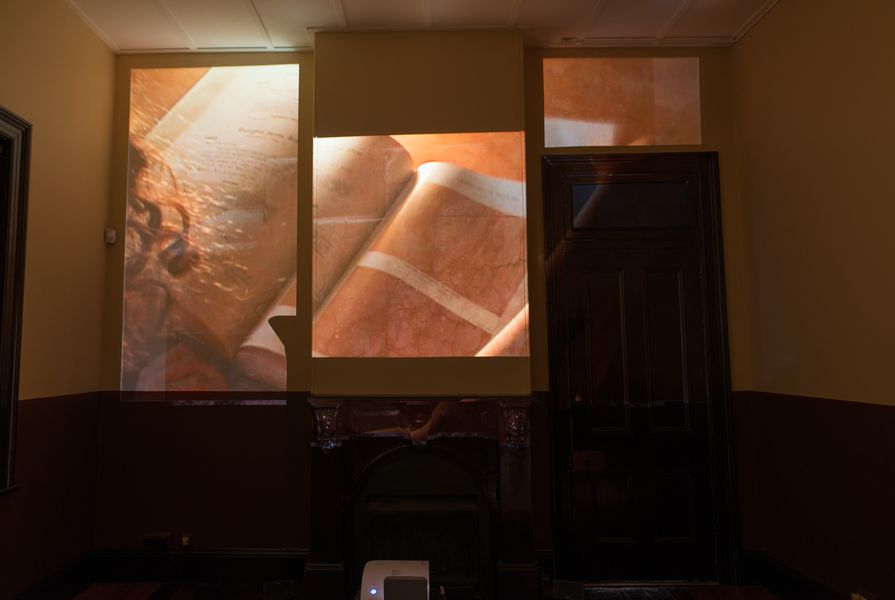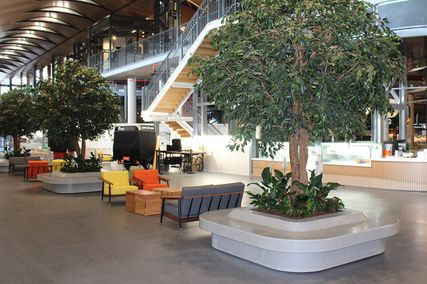Thus Orpheus’s gaze is the extreme moment of freedom, the moment when [it] frees [itself] of [itself] and—what is more important—frees the work of [its] concern, frees the sacred contained in the work, gives the sacred to itself, to the freedom of its essence, to its essence which is freedom, (for this reason, inspiration is the greatest gift). So everything is at stake in the decision of the gaze.
—Maurice Blanchot, The Gaze of Orpheus (p 441)
Reverse Projections, co-curated by Sarah Breen Lovett and Dr Claudia Perren, was an exhibition about the act of looking, but also about multiplicities of time, history and place. It was an exhibition, too, that performed these multiplicities, became them, and went beyond them. It was an exhibition that actively transgressed, shifted and multiplied thought, turning beyond its limits — beyond the diurnal — beyond a divide between past, present and future and into an expanded space, a contracted time, an infinite depth, a night of the night, or what Maurice Blanchot calls, enigmatically, the Other night.1
Reverse Projections was, for a single night, an exhibition. A night where the depths of art were experienced, depths necessary to any work of art.2 In these depths alone a work of art is put to the test and only reveals itself as art in the forbidden act of the reversed gaze — that is, of Eurydice. It began at dusk, but ended in the darkness of night, a darkness and a depth — Orpheus’s descent — which was subject to the power of art, a power causing the night to open, a gaze to turn, and an exhibition to reveal something beyond itself, as a movement into the night.3 Though it was to Reverse Projections that the work and the night seemed to lead, it went beyond this end: becoming a work in its own right, and a movement into the Other night – where the very concealment of the invisible becomes itself the visible, where the work of art, in all its depth, is revealed.4
In(scape) film by Michael Tawa.
Image: Alex Wisser
The exhibition was a series of projections. However, unlike the melodic song of Orpheus, it was comprised of images, installations, and sounds. There were seven works in total, each occupying a locale, a part of the historic house, where each work uncovered something, seemingly concealed, by a gaze in reverse, a gaze into the forgotten — one could say forbidden — past: into the depths of the darkness of the night.
In(scape) film by Lymesmith / Sonia van de Haar.
Image: Alex Wisser
The first work was in the front room, the shop, it was a mesmerizing strata of heritage shades of paint, paint coating twigs, timbers and tables that lay across the room, each revealing something in its surface, and each saying something about its past through its masks, through its own disguise. The next room continued the language of this layering, in a projected montage of images and text. This was an alluring film that recollected a fractured sense of place, of dis-placed histories, composed in a narrative of evocative painterly stills. These two installations together entitled (in)scape: Film, hinted at something essential, primordial, a depth, and a ‘distinctive beauty’, one that takes the work to some ‘where’, to inspiration, to beyond the gaze.5
Blindfold Critique by Joshua David Lynch.
Image: Alex Wisser
On the first floor, in a small kitchenette, it was the lack of sight, that provided a new attunement with the gaze. It was here that one listened to the work, one listened to space. The work, Blind folded Critique, was a landscape of sound that revealed a different spacing, a different horizontality, a different familiarity.6 This distorted sensory perception was also manipulated in the spatial engagement of the next work, a vivid aural-visual performance of synesthesia. This work, Aural Vision; Rocks in Your Head, was a strange resynthesising of the senses, an internal reversal that reconfigured the projection of sound and sight.7
Lying between was the wonderfully mystifying and engaging, A Room An Eye: a constructed Camera Obscura that surreally distorted the physical characteristics of the room, by replaying in real-time, images of an outside, recorded throughout the day, and projected throughout the night, onto its interior walls.8 This contracted, reversed and moving image of the city, the light of day, shifted all sensory perceptions, and an understandings of time, space, and rationality: descending deeper into the depths of a darkness.
A Library of DIY Architecture by Zanny Begg.
Image: Jun Ming
On the second floor, was the archive, A Library of DIY Architecture, which was a provocative and contemplative repository of living urban ideas, one that housed conversations, objects and documents, each reflecting on a framework of thinking futures-to-come.9 Next to it was The Lost Street, a project that actively brought to life the histories of a missing street demolished for the construction of Sydney’s Harbour Bridge.10 Engagingly it produced a new life for the street, through elaborately detailed paper models, digital tracings, and social media, it intertwined the lives and memories of those associated with the lost street, together with those of the present.
Between The Lines by Rachel Couper, Ivana Kuzmanovska and Kate Dunn.
Image: Alex Wisser
The final work was in the courtyard where wavering printed sheets were hung along a series of washing lines strung between the house and the surrounding laneways. The work, Between the Lines, was a strangely familiar sight, where the material danced, twisted and contorted in the wind and the night sky, but it was also an uncanny experience, located between the skyscrapers of the city and the hording tourists.11 It was subtle, it spoke of a silence, a gender, a history, a labour, a work; and like the others, it threw into question the very ethico-aesthetics of art itself.
Reverse Projections was an exhibition, however it was also a symposium that exceeded the work of art, where the power of the night of night was carried into the day, into the following day. The symposium occupied the same space but a different time, a different habit, one that took Reverse Projections into its final leap of inspiration, into the gaze beyond all reserve, and into a new depth by turning and re-turning again. It was in each of the eight papers presented, that Reverse Projections set free, the essence of the night by interrupting the incessant day in order to reveal the darkness of the infinite sojourn.12
The symposium began with the beguiling and thought-provoking paper, Unseemly Projections: Cinema/Architecture.13 This was a poetic paper, one that explored the very thresholds of art and its transgressive limits between the spatial and the temporal. It was also a paper that registered the very possibility of a second descent into the forbidden projection, into the infinite darkness. It was in this descent that the next paper, Subject, Site and Sight: Freud and Tschumi on the Acropolis, opened up, or multiplied, the indeterminacies of the gaze.14 Together these two papers revealed something of the unheimlich (unhomely), a theme taken up in the third paper titled Unhomely, about the un-seen histories of The Rocks.15
It was in the fourth paper, Rematerialising Heritage, that the act of the reversal, was in fact, re-enacted through memory, in a discussion around one of the works seen the previous night.16 This enfolding of time, a time gone but not forgotten, was the focal point of the following two papers An Important Survivor,17 and Contemporary Site Investigations.18 These papers considered the unobtainable essence of the work, and discussed it in relation to site, ritual and presence. This notion of ritual, and the turning of day to night, was further unpacked in the paper Urban Interior Atmosphere: Flinders Lane, Melbourne Diurnal.19 It was in the final paper, A Room An Eye: Situated, that a connection was made between all of them, between light and dark, between desire and inspiration: the desire to gaze that which is obscured, to transgress the day and move into the limitlessness of the night, to reveal the inessential of the essential, and to move toward a freedom of thought.20
In its entirety, Reverse Projections was more than an exhibition, it was a work of art in itself. It was a performance, an act of the gaze, a gaze coming out of the forbidden reversal, a gaze provoking, projecting, questioning, and in so doing moved the work beyond what underwrote it, and established it as a gift of new thought, an indeterminable space of inspiration, in its acts of transgression, and in the descent into the depths of the Other night.21
—Victoria Jackson Wyatt is an artist and architectural graduate practising in Australia and New Zealand. She is currently working on her PhD at the University of Sydney, focusing on the relationship between architecture and literature.
Expanded Architecture was founded in 2010 by Sarah Breen Lovett as Sydney’s first international architectural film festival and panel discussion. It continues as an annual exhibition and symposium on the Sydney Architecture Festival calendar.
1 Maurice Blanchot, “The Gaze of Orpheus,” in The Station Hill Blanchot Reader: Fiction & Literary Essays (Barrytown, N.Y: Station Hill/Barrytown, Ltd, 1999). p 437.
2 Ibid. p 437.
3 Ibid. p 437.
4 Ibid. p 437.
5 Michael Tawa and Lymesmith/Sonia Van de Haar, (in)Scape: Film 2013.
6 Joshua Lynch and Richard Goodwin, Blind folded critique, 2013.
7 Edward Leckie and Lindsay Webb, Aural Vision; Rocks in Your Head, 2013.
8 Ross Anderson, Simon Weir and Kevin Liu, A Room An Eye, 2013.
9 Zanny Begg, A library of DIY Architecture, 2013.
10 Cristina Caruno, Antonia Fredman and Vicki Leibowitz, The Lost Street, 2013.
11 Rachel Couper, Ivana Kuzmanovska and Kate Dunn, Between the Lines, 2013.
12 Blanchot, “The Gaze of Orpheus.” p 439.
13 Tawa, Unseemly Projections: Cinema/Architecture, 2013.
14 Thea Brejzek and Lawrence Wallen, Subject, Site And Sight: Freud And Tschumi On The Acropolis, 2013.
15 Kate Richards, Unhomely, 2013.
16 Caruno, Fredman and Leibowitz, Rematerialising Heritage, 2013.
17 Yvette Hamilton, An Important Survivor, 2013.
18 Campbell Drake, Contemporary Site Investigations, 2013.
19 Rochus Urban Hinkel, Urban Interior Atmosphere: Flinders Lane, Melbourne Diurnal, 2013.
20 Anderson, A Room An Eye: Situated, 2013.
21 Blanchot, “The Gaze of Orpheus.” P441.




























